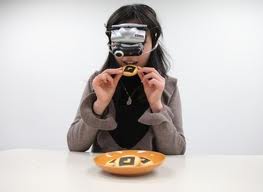
A New Way of Looking at Food?
Tokyo researchers asked a group of volunteers wearing “diet distorting” goggles to eat as many Oreo cookies as they needed to feel satisfied. Unbeknownst to the participants, they used glasses that changed the size of the cookies as viewed through the goggles so they appeared 50% larger than they actually were. The participants’ hands still appeared normal in size. The results? After increasing the size of the cookies, the cookie munchers ate 10% fewer cookies than when the cookies appeared to be their true size. By creating the illusion that the cookies were larger than they actually were, the participants ate less.
Factors like the expansion of your stomach and the composition of what you’re eating affect satiety. These factors cause the release of satiety hormones that feedback to the brain to signal that you’re full. But it’s not really as straightforward as textbooks say it is. Factors like how the food looks and smells, how it tastes, the mood you’re in while you’re eating as well as factors like who you’re eating with and what you’re doing while you eating affect satiety. In addition, this study shows that how much you think you’re putting into your stomach may be just as important as how much you are. If you see a cookie or a meal as being larger than it actually is, you trick your brain into thinking you’ve eaten more, and you feel satisfied more quickly.
Food Cues Affect How Much You Eat
You may not be ready to go out and purchase a pair of goggles to make your food look bigger, but you can use some simple tactics to trick your eyes and brain into feeling satisfied with less. Research shows that something as simple as placing your food on a smaller plate can help you be satisfied with less. This can still be a problem when you go to a restaurant, and they set a giant plate of food on the table. Just ask for a to-go container and remove a portion of your meal to take home.
Even the color plate you eat on and the tablecloth on the table has an impact on how soon you feel full. Research shows that red, orange and yellow plates and tablecloths activate appetites and motivate people to eat more, while people eat less when they dine on blue plates. There’s a reason why fast food signs are usually red, orange and yellow – and almost never blue.
Other Tips for Tricking Your Brain into Feeling Satisfied
Use chopsticks or a smaller fork to eat a meal. You’ll take smaller bites, but your brain will sense you’re taking more bites and that you’re getting more food than you are.
Don’t eat in front of the television set, when you’re reading a book or when working on the computer. Multitaskers eat more than people who concentrate on the taste, sight, and smell of what they’re eating.
Get in touch with your satiety signals. Sometimes your brain signals that you’re full, but you ignore it because you’re distracted. (It’s that multitasking thing again) Learn to recognize the first signs that you’re getting full and stop eating.
Say no to second helpings. Teach yourself to be satisfied with eating a single plate of food. Keep serving dishes off the table so you can’t easily refill your plate. Limit the amount of food you prepare so you can’t have seconds.
Most importantly, don’t eat mindlessly without letting the taste and texture of the food you’re eating register with your brain. Force yourself to slow down the pace of your meal and focus eating until it becomes a habit.
The Bottom Line?
It doesn’t take a pair of food distorting goggles to eat less. Be aware, be a mindful eater – and don’t eat on big, orange plates.
References:
American Journal of Physiology-Gastrointestinal and Liver Physiology. January 1, 2004. Volume 286. No. 1.
Food Product Design “Diet Goggles Alter Perception of Food”
Related Articles By Cathe:
5 Ways to Curb Mindless Overeating

